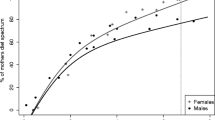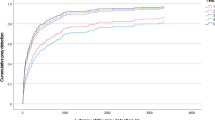Abstract
Captive-raised mustelids appear to have a rudimentary capacity to kill prey, but the skills necessary for locating prey may be eroded during captivity. We tested the maturational component of prey-searching behavior with captive-raised Siberian polecats (Mustela eversmanni) by subjecting polecats to a simulated prairie dog colony of 6 burrows within a 200 m2 arena. Ten naive Siberian polecats at ages 2.5, 3.5, and 4.5 months (30 total) were deprived of food for 12 hours. A dead prairie dog was placed in 1 prairie dog burrow and the other 5 were empty. A single Siberian polecat was released onto the colony shortly before sunset and its movements monitored from an observation tower. Older Siberian polecats located prey significantly quicker than younger polecats, but all age groups spent a great deal of time in surface activity not directed toward a burrow. When Siberian polecats were about 10 months old, all burrows in the arena were plugged with dirt including the burrow with the prairie dog. In this winter test, Siberian polecats located the prey but still spent a great deal of time in non-burrow directed surface activity. Economical use of surface time, with a low amount of non-burrow directed behavior, would presumably reduce the risk of predation for hunting polecats.
Similar content being viewed by others
References
Anderson, E., S.C. Forrest, T.W. Clark, and L. Richardson. 1986. Paliobiology, biogeography, and systematics of the black-footed ferret,Mustela nigripes, (Audubon and Bachman, 1851).Great Basin Naturalist Memoirs 8: 11–62.
Beck, B.B., D.G. Kleiman, I. Castro, B. Rettburg-Beck, and C. Carvalho. in press. Preparation of captive-born golden lion tamarin for release into the wild. In:A Case Study in Conservation Biology: The Golden Lion Tamarin. Ed. D.G. Kleiman.
Biggins, D.E. and K.A. Fagerstone. 1984. Movements and activity of black-footed ferrets (Mustela nigripes). American Society of Mammaologists 64th annual Meeting. (Abs.).
Biggins, D.E., M. Schroeder, S. Forrest, and L. Richardson. 1985. Movements and habitat relationships of radio-tagged black-footed ferrets. In “Black-footed Ferret Workshop Proceedings, Laramie, September 18–19, 1984”. Eds. S.H. Anderson and D.B. Inkley. Wyoming Game and Fish Dept., Cheyenne, WY. pp. 11.1–11.17.
Biggins, D.E., M.H. Schroeder, S.C. Forrest, and L. Richardson. 1986. Activity of radiotagged black-footed ferrets.Great Basin Naturalist Memories 8: 135–140.
Biggins, D.E. and R.C. Crete. in press. Black-footed ferret recovery. In:Nineth Great Plains Wildlife Damage Control Workshop, Ft. Collins CO, April 17–20, 1989.
Caro, T. 1989. Missing links in predator and anti-predator behavior.Trends in Ecology and Evolution 4: 333–334.
Clark, T.W. 1987. The black-footed ferret: A progress report.Conservation Biology 1: 8–11.
Clark, T.W. 1989. Conservation biology of the black-footed ferret (Mustela nigripes). Special Scientific Report No. 3, Wildlife Preservation Trust International, Jersey UK.
Clark, T.W., L. Richardson, D. Casey, T.M. Campbell, and S.C. Forrest. 1984. Seasonality of black-footed ferret diggings and prairie dog burrow plugging.Journal of Wildlife Management 48: 1441–1444.
Clark, T.W., L. Richardson, S.C. Forrest, D.E. Casey, and T.M. Campbell. 1986. Descriptive ethology and activity patterns of black-footed ferrets.Great Basin Naturalist Memoirs #8: 115–134.
Deni, R., K. Szijarto, A. Eisler, and C. Fantauzzo. 1983. Basic programs for observational research using the TRS-80 Model 100 portable and Model 4 computers.Behavioral Research Methods and Instrumentation 15: 616.
Forrest, S.C., T.W. Clark, L. Richardson, D. Biggins, K. Fagerstone, and T.M. Campbell. 1985. Life history characteristics of the genusMustela, with special reference to the black-footed ferret,Mustela nigripes. Black-footed Ferret Workshop Proceedings. Wyoming Game and Fish Department, Cheyenne WY.
Forrest, S.C., D.E. Biggins, L. Richardson, T.W., Clark, T.W. Campbell, K.A. Fagerstone, and E.T. Thorne. 1988. Black-footed ferret (Mustela nigripes) population attributes at Meeteetse, WY 1981–1985.J. Mammal. 69: 261–273.
Gossow, H. 1970. Vergleichende verhaltensstudien an Marderartigen I. uber Lautausserungen und zum Beuteurhalten.Z. Tierpsychol. 27: 405–480.
Henderson, R.P., P.F. Springer, and R. Adrian. 1974. The black-footed ferret in South Dakota.South Dakota Dept. Game, Fish, and Parks Technical Bulletin no. 4, 37 pp.
Hillman, C.N. 1968. Field observations of black-footed ferrets in South Dakota.Transactions of the North American Wildlife and Natural Resources Conference 33: 433–443.
Hoffman, R.S. and D.L. Pattie. 1968. A guide to Montana mammals. University of Montana, Missoula.
Kelly, G.M. 1977. Fisher (Martes pennanti) biology in the white Mountain National Forest and adjacent areas. Ph.D. Dissertation. University of Massachusetts.
Miller, B.J., S.H. Anderson, M.J. DonCarlos, E.T. Thorne, 1988. Biology of the endangered black-footed ferret anda the role of captive propagation in its conservation.Canadian Journal of Zoology 66: 765–773.
Miller, B.J. and S.H. Anderson. in press. Ethology of the endangered black-footed ferret. In:Advances in Ethology. Paul parey Scientific Publ. Berlin.
Nams, V. 1981. Prey selection mechanisms of the ermine (Mustela erminea). In:First Worldwide Furbearer Conference Proceedings. Eds. J.C. Chapman and D. Pursley. Worldwide Furbearers Conference Inc., Baltimore MD. pp. 861–882.
Polsky, R.H. 1975. Developmental factors in mammalian predation.Behavioral Biology 15: 353–382.
Powell, R.A. 1981. Hunting behavior and food requirements of the fisher (Martes pennanti). In:First Worldwide Furbearer Conference Proceedings. Eds. J.A. chapman and D. Pursley. Worldwide Furbearers Conference Inc., Baltimore MD. pp. 883–913.
Powell, R.A. 1982. The Fisher. University of Minnesota Press, Minneapolis Minnesota.
Richardson, L., T.W. Clark, S.C. Forrest, and T.M. Campbell. 1987. Winter ecology of the black-footed ferret at Meeteetse Wyoming.American Midland Naturalist 117: 225–239.
Seal, U.S., S.H. Anderson, M. Bogan, and E.T. Thorne. 1989. Conservation Biology of the Black-footed Ferret. Yale University Press, New Haven, Conn.
Stronganov, S. U. 1962. Carnivorous Mammals of Siberia. Academy of Science of the U.S.S.R. Siberian Branch. (Israeli Program Scientific Translations). pp. 351–394.
Thorne, E.T. and E.S. Williams. 1988. Disease and endangered species: The black-footed ferret as a recent example.Conservation Biology 2: 66–74.
U.S. Fish and Wildlife Service. 1988. Black-footed ferret recovery plan. USFWS. Denver, CO.
Wustehusse, C. 1960. Beirge zur Kenntnis besonders des Spiel und Beutefangverhaltens einheimischer Musteliden.Z. Tierpsychologie 17: 576–613.
Zar, J.H. 1984. Biostatistical Analysis. Prentice-Hall Inc., Englewood Cliffs, NJ.
Author information
Authors and Affiliations
About this article
Cite this article
Miller, B., Biggins, D., Wemmer, C. et al. Development of survival skills in captive-raised Siberian polecats (Mustela eversmanni) I: Locating prey. J. Ethol. 8, 89–94 (1990). https://doi.org/10.1007/BF02350279
Received:
Accepted:
Issue Date:
DOI: https://doi.org/10.1007/BF02350279




